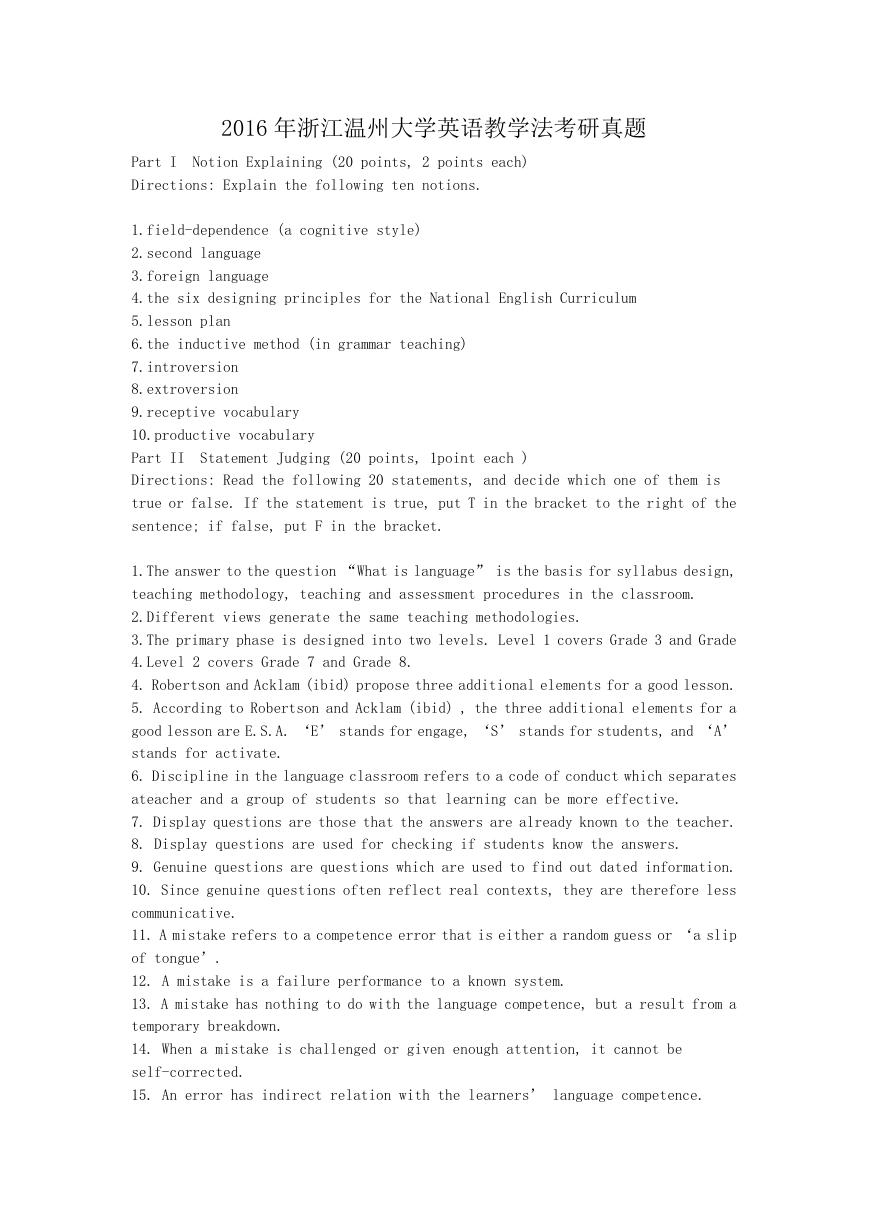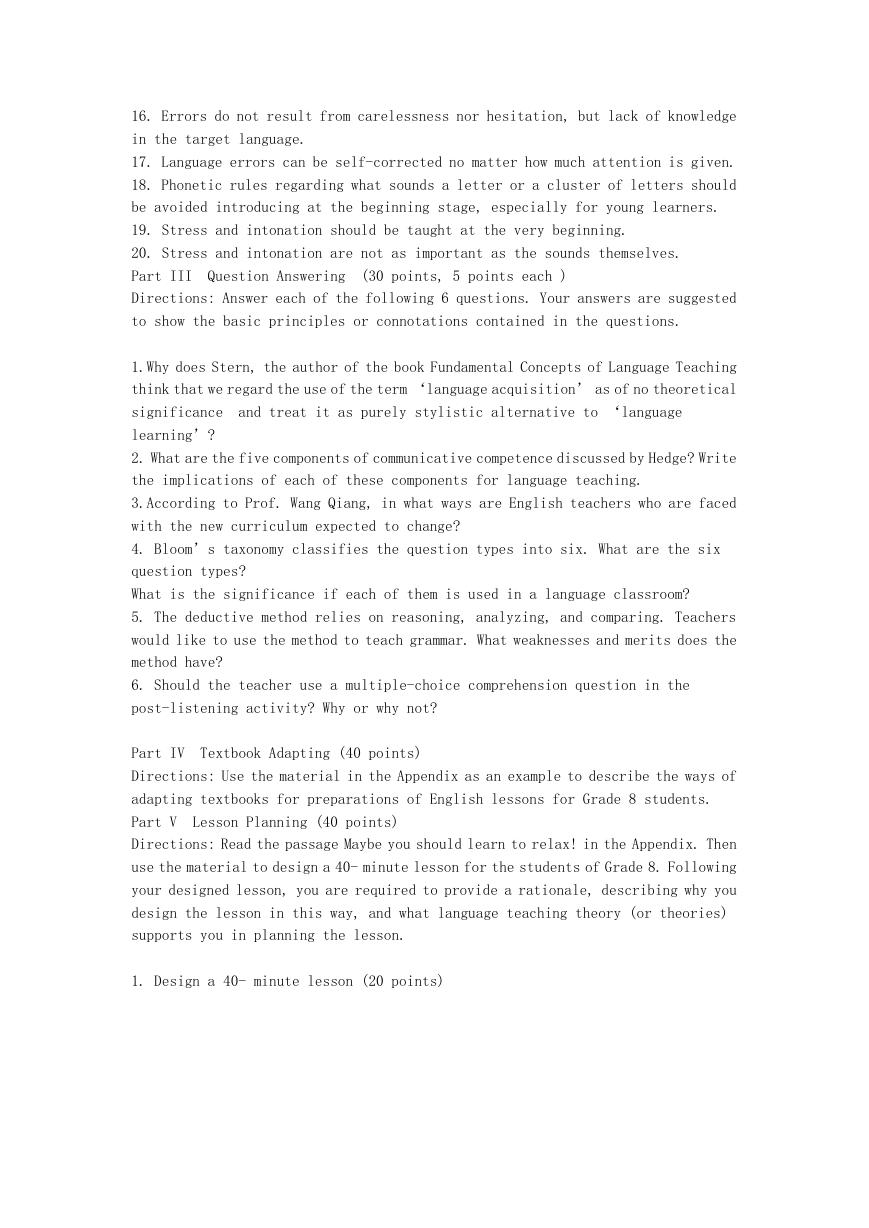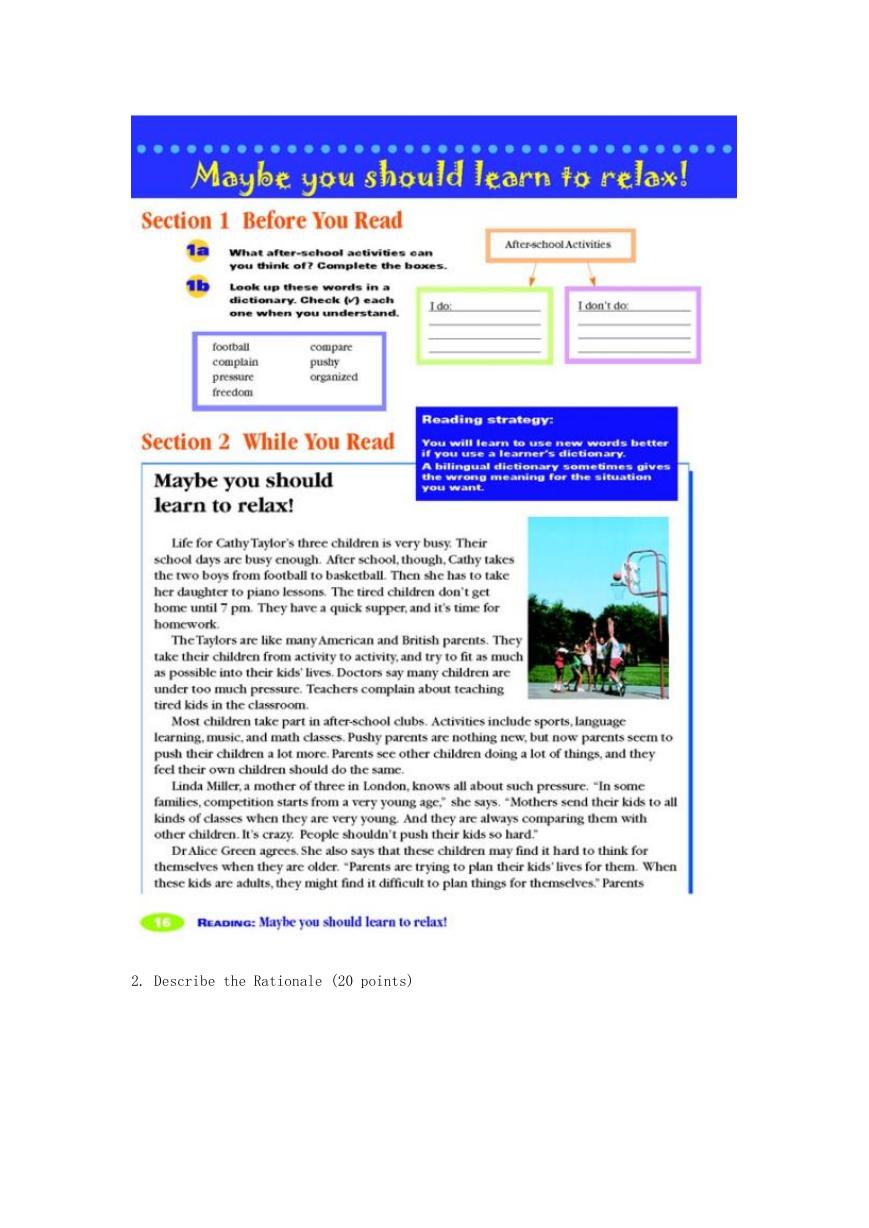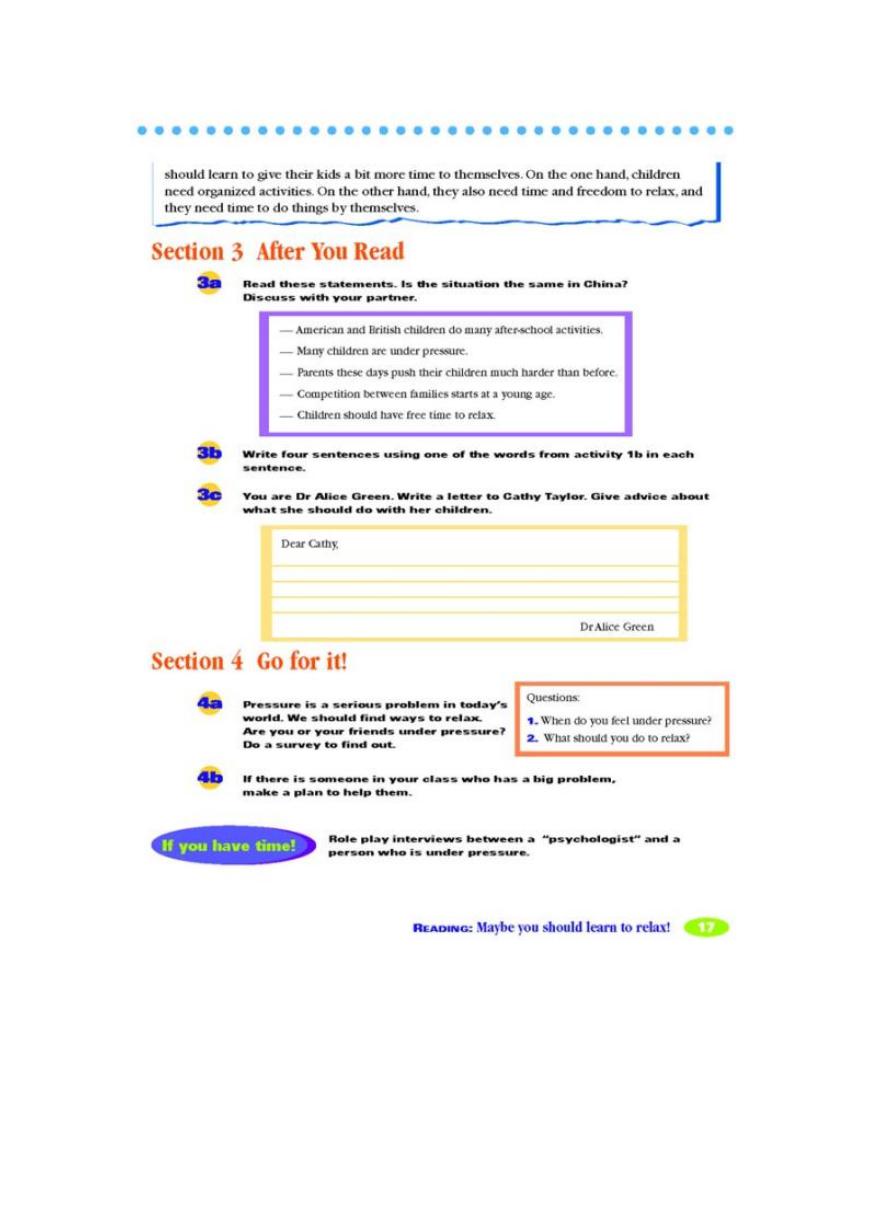2016 年浙江温州大学英语教学法考研真题
Notion Explaining (20 points, 2 points each)
Part I
Directions: Explain the following ten notions.
1.field-dependence (a cognitive style)
2.second language
3.foreign language
4.the six designing principles for the National English Curriculum
5.lesson plan
6.the inductive method (in grammar teaching)
7.introversion
8.extroversion
9.receptive vocabulary
10.productive vocabulary
Part II
Directions: Read the following 20 statements, and decide which one of them is
true or false. If the statement is true, put T in the bracket to the right of the
sentence; if false, put F in the bracket.
Statement Judging (20 points, 1point each )
1.The answer to the question “What is language” is the basis for syllabus design,
teaching methodology, teaching and assessment procedures in the classroom.
2.Different views generate the same teaching methodologies.
3.The primary phase is designed into two levels. Level 1 covers Grade 3 and Grade
4.Level 2 covers Grade 7 and Grade 8.
4. Robertson and Acklam (ibid) propose three additional elements for a good lesson.
5. According to Robertson and Acklam (ibid) , the three additional elements for a
good lesson are E.S.A. ‘E’ stands for engage, ‘S’ stands for students, and ‘A’
stands for activate.
6. Discipline in the language classroom refers to a code of conduct which separates
ateacher and a group of students so that learning can be more effective.
7. Display questions are those that the answers are already known to the teacher.
8. Display questions are used for checking if students know the answers.
9. Genuine questions are questions which are used to find out dated information.
10. Since genuine questions often reflect real contexts, they are therefore less
communicative.
11. A mistake refers to a competence error that is either a random guess or ‘a slip
of tongue’.
12. A mistake is a failure performance to a known system.
13. A mistake has nothing to do with the language competence, but a result from a
temporary breakdown.
14. When a mistake is challenged or given enough attention, it cannot be
self-corrected.
15. An error has indirect relation with the learners’ language competence.
�
16. Errors do not result from carelessness nor hesitation, but lack of knowledge
in the target language.
17. Language errors can be self-corrected no matter how much attention is given.
18. Phonetic rules regarding what sounds a letter or a cluster of letters should
be avoided introducing at the beginning stage, especially for young learners.
19. Stress and intonation should be taught at the very beginning.
20. Stress and intonation are not as important as the sounds themselves.
Part III Question Answering
Directions: Answer each of the following 6 questions. Your answers are suggested
to show the basic principles or connotations contained in the questions.
(30 points, 5 points each )
1.Why does Stern, the author of the book Fundamental Concepts of Language Teaching
think that we regard the use of the term ‘language acquisition’ as of no theoretical
significance and treat it as purely stylistic alternative to ‘language
learning’?
2. What are the five components of communicative competence discussed by Hedge? Write
the implications of each of these components for language teaching.
3.According to Prof. Wang Qiang, in what ways are English teachers who are faced
with the new curriculum expected to change?
4. Bloom’s taxonomy classifies the question types into six. What are the six
question types?
What is the significance if each of them is used in a language classroom?
5. The deductive method relies on reasoning, analyzing, and comparing. Teachers
would like to use the method to teach grammar. What weaknesses and merits does the
method have?
6. Should the teacher use a multiple-choice comprehension question in the
post-listening activity? Why or why not?
Lesson Planning (40 points)
Textbook Adapting (40 points)
Part IV
Directions: Use the material in the Appendix as an example to describe the ways of
adapting textbooks for preparations of English lessons for Grade 8 students.
Part V
Directions: Read the passage Maybe you should learn to relax! in the Appendix. Then
use the material to design a 40- minute lesson for the students of Grade 8. Following
your designed lesson, you are required to provide a rationale, describing why you
design the lesson in this way, and what language teaching theory (or theories)
supports you in planning the lesson.
1. Design a 40- minute lesson (20 points)
�
2. Describe the Rationale (20 points)
�
�








 2023年江西萍乡中考道德与法治真题及答案.doc
2023年江西萍乡中考道德与法治真题及答案.doc 2012年重庆南川中考生物真题及答案.doc
2012年重庆南川中考生物真题及答案.doc 2013年江西师范大学地理学综合及文艺理论基础考研真题.doc
2013年江西师范大学地理学综合及文艺理论基础考研真题.doc 2020年四川甘孜小升初语文真题及答案I卷.doc
2020年四川甘孜小升初语文真题及答案I卷.doc 2020年注册岩土工程师专业基础考试真题及答案.doc
2020年注册岩土工程师专业基础考试真题及答案.doc 2023-2024学年福建省厦门市九年级上学期数学月考试题及答案.doc
2023-2024学年福建省厦门市九年级上学期数学月考试题及答案.doc 2021-2022学年辽宁省沈阳市大东区九年级上学期语文期末试题及答案.doc
2021-2022学年辽宁省沈阳市大东区九年级上学期语文期末试题及答案.doc 2022-2023学年北京东城区初三第一学期物理期末试卷及答案.doc
2022-2023学年北京东城区初三第一学期物理期末试卷及答案.doc 2018上半年江西教师资格初中地理学科知识与教学能力真题及答案.doc
2018上半年江西教师资格初中地理学科知识与教学能力真题及答案.doc 2012年河北国家公务员申论考试真题及答案-省级.doc
2012年河北国家公务员申论考试真题及答案-省级.doc 2020-2021学年江苏省扬州市江都区邵樊片九年级上学期数学第一次质量检测试题及答案.doc
2020-2021学年江苏省扬州市江都区邵樊片九年级上学期数学第一次质量检测试题及答案.doc 2022下半年黑龙江教师资格证中学综合素质真题及答案.doc
2022下半年黑龙江教师资格证中学综合素质真题及答案.doc